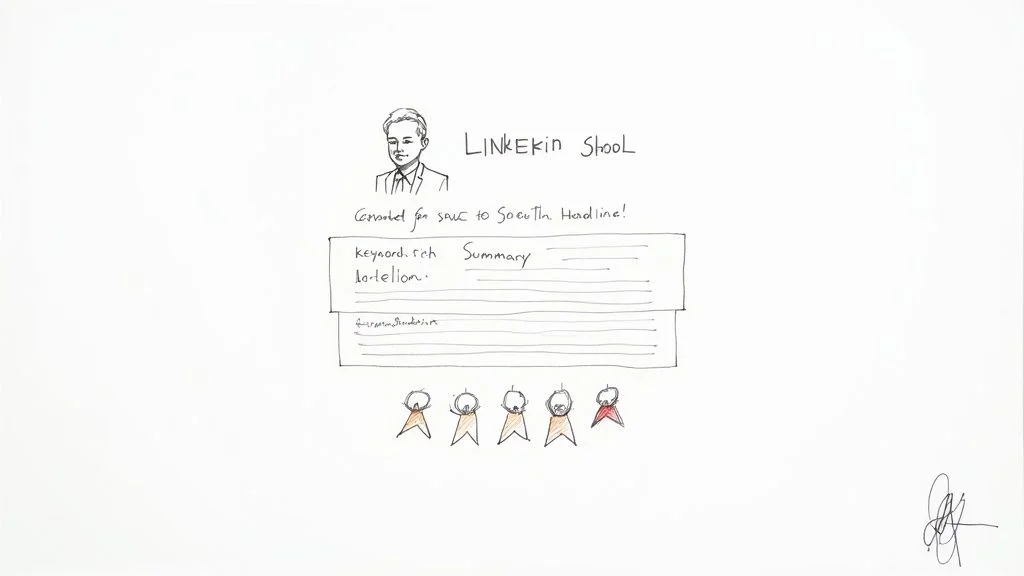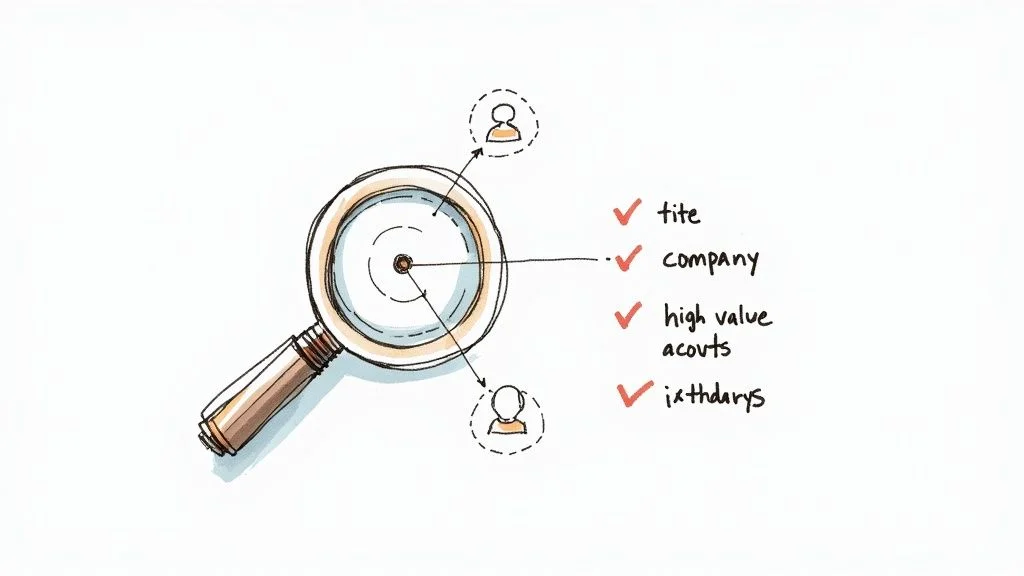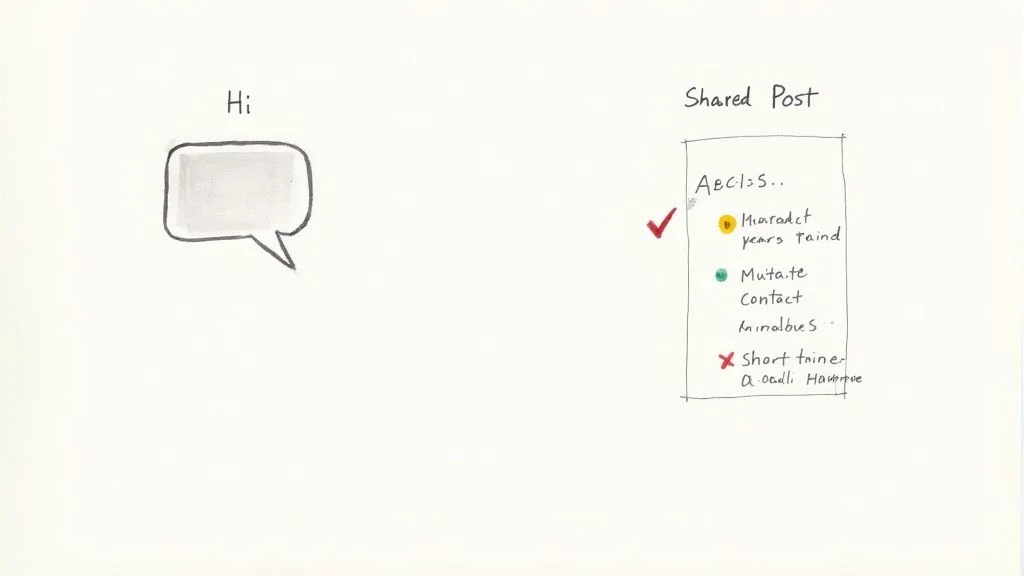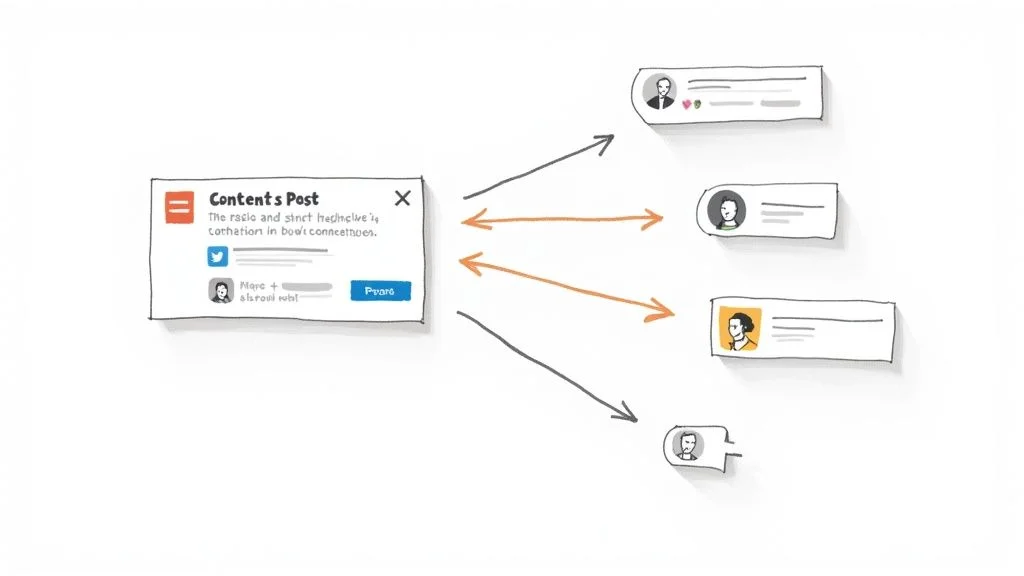How to Get Connections on LinkedIn: Grow Your Network Fast
Build a connection-ready LinkedIn profile and master strategic outreach. Learn proven techniques to grow your professional network rapidly and authentically.

how to get connections on linkedin: Grow your network fast
Want to get more connections on LinkedIn? It all starts with your profile. Before you even think about outreach, you need a profile that makes people want to connect with you.
This isn't about just listing your past jobs. It's about turning your page into a professional brand headquarters—your digital handshake. And in the professional world, a weak handshake can kill a deal before it even starts.
Build a Connection-Ready LinkedIn Profile
Think of it this way: your LinkedIn profile does the heavy lifting for you. It's the foundation of your entire networking strategy. When someone gets a connection request from a profile that's half-finished or generic, what does that say? It signals a lack of effort, and people will be far less likely to click "Accept."
The goal is to transform your profile into a credible, compelling resource that makes connecting with you a no-brainer.

This process is more than just filling in the blanks. It’s a strategic effort centered on clarity, value, and a touch of personality.
Craft Your Professional Narrative
Your headline and summary are the first things people read. They're your 24/7 elevator pitch, so make them count.
Your Headline: This is so much more than just your job title. It needs to scream value. A great headline clearly states who you help, how you do it, and what makes you different. Instead of a bland "Marketing Manager at Company X," try something like, "B2B Content Marketer | Helping SaaS Startups Drive Leads Through Storytelling." See the difference? One is a label; the other is a solution.
Your Summary (About Section): This is your chance to tell a story. Don't just list skills—explain your "why." What gets you excited about your work? Write in the first person to build a direct, human connection with the reader. And please, break up the text into short, scannable paragraphs. No one wants to read a wall of text.
A bland profile is like a restaurant with a six-page menu—it can't possibly do everything well. A focused, well-crafted profile is like a curated menu; every item is there for a reason and has been perfected.
Showcase Results, Not Just Responsibilities
When you get to your work experience, shift your mindset from duties to achievements. Anyone can list what they were supposed to do. Top professionals show the impact they made.
Instead of writing, "Managed social media accounts," quantify it. Try this: "Grew organic social media engagement by 45% in six months by implementing a new content strategy." That little change makes a huge difference. It proves your expertise and shows you deliver real value. Use punchy bullet points with strong action verbs to make your wins pop.
Gather Social Proof and Credibility
Endorsements and recommendations are your secret weapon. They serve as testimonials for your professional brand, offering third-party validation that's way more powerful than you singing your own praises.
Be proactive here. Reach out to former colleagues, managers, or clients and ask for a recommendation. Don't just send a generic request—personalize it! Remind them of a specific project you rocked together. This social proof adds a thick layer of trust and credibility that makes your profile incredibly persuasive.
To help you get everything in order, I've put together a quick checklist. Run through this to make sure your profile is ready to make a killer first impression.
Your LinkedIn Profile Optimization Checklist
Use this checklist to ensure every part of your profile is optimized to attract high-quality connections.
| Profile Element | Optimization Goal | Why It Matters |
|---|---|---|
| Profile Photo | A clear, professional headshot where you look approachable. | It’s your first impression. A good photo builds instant trust. |
| Banner Image | A custom graphic that reflects your brand or industry. | It’s prime real estate to show personality and expertise. |
| Headline | A value-driven statement, not just a job title. | Quickly tells people what you do and who you help. |
| About Section | A compelling, first-person narrative showcasing your "why." | Connects with readers on a personal level and tells your story. |
| Experience Section | Bullet points with quantified achievements, not just duties. | Demonstrates your impact and proves your value. |
| Skills & Endorsements | List at least 5 relevant skills with multiple endorsements. | Provides quick validation of your key strengths. |
| Recommendations | At least 2-3 genuine recommendations from past colleagues. | Offers powerful social proof from people who have worked with you. |
| Custom URL | A clean, personalized URL (e.g., /in/yourname). | Looks professional and is easier to share. |
Once you can check off every item on this list, your profile is no longer just a resume—it’s a networking machine, primed and ready to help you build meaningful connections.
Alright, with a polished profile ready to make a great first impression, it's time to find the right people.
Just blasting out connection requests is a rookie mistake. It's like shouting into a hurricane—you're making a lot of noise, but nobody's really listening. Real growth on LinkedIn comes from being selective and strategic. Every single connection request should have a clear purpose behind it.
Think about it: your time is your most valuable asset. Wasting it trying to connect with people who have zero relevance to your goals is a dead end. Whether you're hunting for new clients, seeking out mentors, or trying to get on a hiring manager's radar, you need a focused game plan.

Go Way Beyond the Basic Search Bar
Most people barely scratch the surface of LinkedIn's search capabilities. They type in a name or company and call it a day. But the real power is in the filters. This is where you can get surgical and build hyper-targeted lists of prospects.
First, get crystal clear on who your ideal connection is. What’s their job title? What industry are they in? Where do they work? Once you have this down, you can use LinkedIn's filters to zero in on them.
Filter by Title: Want to talk to the decision-makers? Search for titles like "Marketing Director" or "VP of Sales."
Filter by Industry: Need to network within a specific field? You can narrow your search to "Software Development" or "Financial Services."
Filter by Company: If you're targeting a dream company, just add their name to the filters.
This methodical approach takes a platform with over one billion members and turns it into your own curated, high-value contact list. It’s the difference between fishing with a single worm and using a precision-guided net.
Uncover the Hidden Networking Goldmines
While a direct search is great, some of the absolute best connections are found where conversations are already in full swing. These spots are often overlooked, but they're pure gold for finding genuinely engaged professionals.
Your goal isn't just to find people; it's to find people who are actually active. A connection with a ghost account that never logs in does you no good. Put your energy into connecting with people who are part of the conversation.
Here are a few of my favorite places to look:
LinkedIn Groups: Find groups centered around your industry or specific interests. But don't just join and lurk—participate. Pay attention to who the most active contributors are. Engaging with their posts before you send a request is a perfect warm-up. They’ve already shown they’re active and invested.
Competitor Connections: This is a cheeky one, but it works. Check out the connections of a key competitor or a well-respected peer in your space. Their network is probably a pre-vetted list of relevant industry contacts just waiting for you to explore.
Influencer Comment Sections: Identify the heavy hitters and thought leaders in your field. The comment sections on their posts are a treasure trove. The people leaving smart, insightful comments are exactly the kind of engaged, knowledgeable pros you want in your network. Jump into the replies and add to the conversation—it’s the perfect way to get on their radar before you hit "connect."
Write Connection Requests People Actually Accept
Hitting “Connect” and sending the default, "I'd like to add you to my professional network on LinkedIn," is the digital equivalent of a limp handshake. It's forgettable, lazy, and the fastest way to get your request ignored.
If you want people to actually accept, the secret is personalization. It’s the one thing that separates you from the dozens of other generic requests they get every single day.
This doesn't mean you need to write a novel. Seriously, just 30 seconds is all it takes to find a genuine reason to connect. That tiny bit of effort shows you see them as a person, not just another notch on your network belt.

From Generic to Genuine
The goal here is simple: find a common thread and pull on it. A personalized note instantly gives context and builds a bridge.
Here are a few quick ways to find that connection point:
A recent post they shared: "Hi [Name], I really enjoyed your article on the future of AI in marketing. The point you made about ethical data usage was especially insightful. Would love to connect."
A mutual connection: "Hi [Name], I see we're both connected with [Mutual Connection's Name]. I work in a similar space at [Your Company] and would be great to be in your network."
Shared interests or groups: "Hello [Name], I noticed we're both members of the SaaS Growth Hackers group. I’m always keen to connect with fellow marketers in the space."
Company news: "Hi [Name], I saw the announcement about [Their Company]'s recent funding round—congratulations! Exciting times ahead. I’d be honored to connect and follow your journey."
Your connection request is your first impression. A personalized message shows respect for their time and immediately sets a positive tone. It’s the difference between being a stranger and being a potential colleague.
Even a simple, repeatable approach can make a huge difference. For example, well-crafted "connector campaigns" hit an acceptance rate of about 29.61%. Think about that—nearly one in three strategic requests gets accepted. This just proves that a thoughtful message blows a high-volume, generic approach out of the water. You can find more insights about LinkedIn outreach to sharpen your strategy.
Let’s look at two examples side-by-side. The difference is night and day.
| The Weak Request (Default) | The Strong Request (Personalized) |
|---|---|
| “I'd like to add you to my professional network on LinkedIn.” | “Hi Sarah, I just finished reading your latest blog post on project management tools and found your Trello workflow tips incredibly helpful. I’m also a project manager and would love to connect and learn more from your content.” |
The second one is specific, complimentary, and gives a clear why. It’s not a big ask, but it makes a massive impact and sets the stage for a real conversation.
Of course. Here is the rewritten section, designed to sound like an experienced human expert and match the provided writing style.
Let Content Do the Heavy Lifting for You
Outbound connection requests are great, but the real magic happens when people start coming to you. That’s the power of a solid content game. When you consistently share valuable insights, you flip the script entirely.
Instead of hunting for connections, you become a magnet, pulling in a steady stream of requests from exactly the right people.
And no, this doesn't mean you have to quit your day job to become a full-time creator. It’s all about building a presence and showing your expertise through a simple, sustainable content rhythm. Get it right, and your activity becomes a beacon for your authority and generosity.

The best part? You don't need to reinvent the wheel. The most effective content is often just a unique, helpful perspective on a conversation that's already happening.
Find Your Voice (Without Writing a Novel)
Look, you can build a killer presence without ever writing a long-form article. The secret is to consistently offer your unique take on what's happening in your industry.
Here are a few dead-simple content formats that punch way above their weight:
Text-Only Posts: Drop a quick, insightful tip. Share a hard-won lesson from a recent project. Post a bold prediction about your industry. These are fast, easy, and people love to read them.
Share with Your Thoughts: See a great article or report from a source you trust? Don't just hit "share." Add a couple of sentences with your own spin. What’s your biggest takeaway? Do you agree or disagree with the author's main point?
Ask a Question: This is my favorite. Pose a thought-provoking question to your network. It’s a brilliant way to spark real conversation and learn from others, all while positioning yourself as a curious, engaged pro.
These small acts build your voice and establish your expertise over time. For a deeper dive, check out our full guide on building a winning LinkedIn content strategy.
The Real Gold Is in the Comments
Creating your own content is one half of the equation. But the other half—engaging with other people's content—is arguably where the real opportunity lies.
This is how you scale your visibility, fast. Leaving one thoughtful, value-adding comment on a post from an industry leader can put your name and face in front of hundreds, sometimes thousands, of relevant professionals.
Forget "great post!" or "thanks for sharing." Those comments are basically invisible. To actually stand out, you have to add to the conversation. Ask a smart follow-up question. Share a related personal experience. Offer a respectful counterpoint.
This kind of consistent, value-first activity makes you both visible and credible. Before you know it, the very people you want to connect with will already know your name.
Think about the trends. Video content uploads on LinkedIn jumped 34% in just one year. Sharing your expertise there grabs attention. And with 6.3 million people attending virtual events, actively participating in those online spaces is a massive opportunity to grow your network.
It all points to a simple truth: being an active, valuable member of the LinkedIn community is the key to getting more—and better—connections.
Work Smarter, Not Harder: Using AI on LinkedIn
Let's be real: scaling your LinkedIn activity without it turning into a full-time job is tough. The answer isn't to just grind harder—it's to work smarter. This is where AI tools can step in to make your networking more efficient, not less personal.
The whole point isn't to let a robot build your relationships for you. That’s a surefire way to come off as fake. Instead, you can use technology to handle the repetitive stuff, freeing you up to focus on what actually matters: building real, human connections.
Speed Up Your Engagement with an AI Assist
What if you could jump into dozens of conversations every week instead of just a few? That's what's possible with AI. Tools like the ones baked into the Social Presence extension can help you draft insightful comments in seconds, letting you show up in more places and dramatically expand your visibility.
Instead of staring at that blinking cursor, you get a solid starting point. For example, an AI assistant can help you:
Ask a smart question: Generate a follow-up that proves you’ve actually read the post and want to dig deeper.
Add a little value: Come up with a comment that builds on the original idea with a fresh take or a helpful resource.
Share a quick story: Draft a short personal anecdote that connects your own experience to the conversation.
From there, you just need to polish it up to sound like you. This saves a ton of time but keeps your contributions valuable and authentic. Think of it as an assistant, not a replacement. You're always in the driver's seat, making sure every comment reflects your true expertise and personality.
Sharpen Your Strategy with Real Data
How do you even know if your networking is paying off? Guessing isn't a strategy. This is where AI-powered analytics bring some much-needed clarity, showing you what’s actually working so you can do more of it.
The biggest risk with AI isn't just bland, robotic content. It's the temptation to spam comments just because it's easy. A single, thoughtful, human-edited comment will always beat a dozen generic ones. Quality over quantity is the only way to build credibility.
Modern tools can track your activity against goals you set yourself. A simple target, like making 5 meaningful comments a day, builds a powerful and consistent habit.
By keeping an eye on these simple metrics, you can quickly spot which types of posts or engagement tactics are driving the most profile views, landing you new followers, and sparking those all-important inbound connection requests. This data-backed feedback loop is crucial for fine-tuning your approach and making sure your time on LinkedIn is spent on what truly moves the needle—building a powerful professional network.
Why a Strategic Approach to LinkedIn Matters
If you want to truly master getting connections on LinkedIn, you have to understand the sheer scale of the playground you're in. Just showing up and firing off random requests is like trying to whisper in a crowded stadium—you’ll just get lost in the noise.
A strategic, deliberate approach isn’t some "nice to have." It's the only way to build a network that actually moves the needle for your professional goals.
The opportunity here is massive, but so is the competition for attention. Sending a thoughtless, generic connection request or sharing bland content just won't cut it anymore. Your entire approach needs to be built for an audience that is switched on, professionally minded, and looking for genuine value, not just another name in their contact list.
The Numbers Tell the Real Story
To play the game well, you have to know the field. LinkedIn is home to over 1.2 billion members globally, making it the largest professional network on the planet. And these aren't just dormant accounts; with monthly visitor counts hitting around 1.77 billion, it's clear this is a highly active audience, not a digital resume graveyard.
Engagement rates, which recently peaked at a solid 5.76%, prove that users who post quality content get more interaction and, you guessed it, more connections. You can dig deeper into the latest LinkedIn usage statistics and what they mean for you.
This data hammers home one critical lesson: the people you want to connect with are already on the platform, and they're paying attention. Your job is to give them a damn good reason to notice you.
A strategic approach means you stop collecting contacts and start building relationships. It’s the difference between a network that's a mile wide and an inch deep versus one that is a powerful, supportive professional asset.
This data-backed view helps set the right expectations. You aren't just firing requests into a black hole; you're tapping into a thriving, active ecosystem.
Quality Over Quantity Is the Only Rule That Matters
Let's be clear: the goal isn't just to get connections. It's to get the right connections.
A highly relevant network of 500 engaged professionals who actually care about what you do will always be more powerful than 5,000 random contacts who scroll right past your content. Every single action you take—from polishing your profile to the comments you leave—should be seen through this lens.
This means being intentional.
Be purposeful with your time: Focus your energy on the activities that attract the right kind of people.
Provide genuine value: Share insights that actually help, teach, or inspire others in your industry.
Engage thoughtfully: Jump into conversations and build some rapport before you even think about sending a request.
Ultimately, a strategic approach respects both your time and everyone else's. It turns your LinkedIn activity from a chore into a focused, effective engine for career growth.
Knowing what to do is only half the battle; knowing when to do it is just as crucial. For example, our data-driven guide can show you the best times to post on LinkedIn in 2025 to get maximum visibility with your target audience. This is how you stop being a passive user and start becoming a respected voice.
Your Top LinkedIn Connection Questions, Answered
As you start getting serious about growing your network, a few questions always pop up. It's totally normal. Getting the strategy right from the start can save you a ton of headaches and help you avoid the common mistakes that stunt your growth.
Let's clear up some of the most common uncertainties.
How Many Connection Requests Can I Send a Day?
LinkedIn is pretty tight-lipped about the exact weekly limits they impose to fight spam, but that's not the number you should be worried about anyway. The real magic is in quality over quantity.
Forget blasting out hundreds of generic requests. You'll hit the limit fast and get a low acceptance rate for your trouble. A much smarter approach is to aim for 10-20 highly personalized requests a day. This keeps your account in good standing and, more importantly, actually gets you the connections you want.
What’s the Best Thing to Say After We Connect?
This is where the real work begins. The absolute worst thing you can do is immediately launch into a sales pitch or ask for something. Don't be that person.
Instead, just open the door for a real conversation. A simple thank-you message is all you need.
Here's a simple template: "Thanks for connecting, [Name]! I really enjoyed your recent post on [topic]. It’s great to have you in my network."
The goal is just to build a little rapport. You're not closing a deal on day one. A genuine, appreciative note sets the right tone for everything that follows.
Should I Focus on More Connections or More Followers?
Ah, the classic debate. The answer really boils down to what you're trying to achieve on the platform. They serve very different functions, and knowing which one to prioritize is crucial. We break this down in detail in our guide on LinkedIn followers vs connections.
Here’s the short version:
Connections are a two-way relationship. You can message each other directly, and you see each other's updates. This is perfect if you're in sales, business development, or want to build a tight-knit professional circle.
Followers are more of a one-way street. They see your content, but you don't necessarily see theirs. This is ideal for thought leaders, creators, or anyone focused on broadcasting a message to a wide audience.
For most people, a hybrid approach works best. Concentrate on building a solid base of quality connections while also creating content that naturally attracts followers. This gives you the best of both worlds: a strong inner circle and a broad, influential reach.
Ready to make your LinkedIn engagement smarter and more efficient? Social Presence helps you show up consistently and build meaningful connections with AI-assisted comments and powerful workflow tools. Try it for free today.